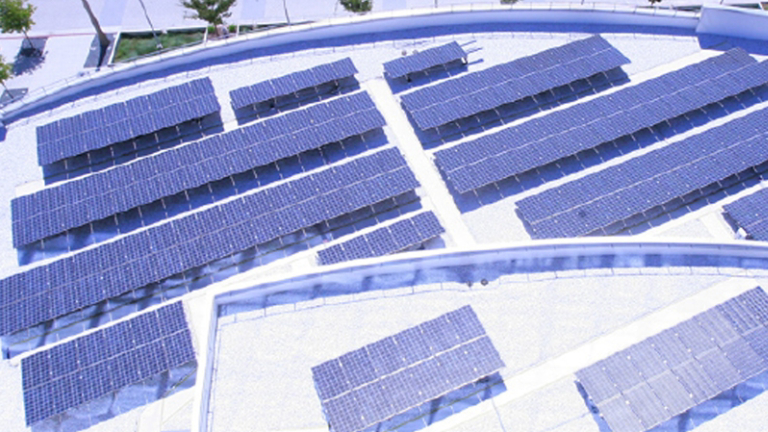Customer Story
Zero Net Energy and LEED Gold: California State Lottery Headquarters’ Innovative Energy Solutions
The California State Lottery Headquarters partnered with Trane to create a sustainable and energy-efficient facility, including a Zero Net Energy pavilion, using solar panels and ice-based energy storage, while achieving LEED Gold certification and reducing cooling costs during peak hours by 21 percent.
Quick Facts
- Location
- Sacramento, California
- Industry
- Commercial Real Estate
- Products
- Chillers • Energy Storage • Series R Helical Rotary Screw Chillers
- Topics
- Sustainability • Innovation • Efficiency • Cost-Saving • Optimal Comfort
- Services
- Upgrading

Challenge
Occupying a building that was inefficient and expensive to operate, California State Lottery (Lottery) sought to construct a new headquarters that would be both functional and energy efficient. A major feature of the new building design included the construction of a Zero Net Energy (ZNE) pavilion. For the pavilion to achieve ZNE classification, it had to be designed to operate using no more energy than is provided by its own on-site generation. Of course, this would need to be accomplished without compromising occupant comfort.
Lottery officials required the new facility to comply with Title 24, California Code of Regulations, which specifies building energy efficiency requirements and ultimately reduces source energy consumption. The officials also wanted the building to achieve LEED Gold certification.
“The state’s focus was to make this building energy efficient, while being fiscally responsible,” said Mike Stanton, mechanical engineer, Interface Engineering. “Besides meeting Title 24, California Code of Regulations energy efficiency targets, we also wanted to create a Zero Net Energy pavilion that could supply renewable energy to the rest of the building.”
It was important for the building design to integrate technologies that could provide a steady return on investment. Project leaders decided to use solar panels in the design of the pavilion and ice-based energy storage throughout the entire facility. These features would reduce operating costs once the project was complete and create a quicker payback period.
Solution
Lottery partnered with Trane for the facility’s mechanical systems based on the company’s ability to provide a complete solution, and their expertise in designing a system to meet project goals. Trane proposed CALMAC® Ice Bank® energy storage tanks combined with Trane® Series R® high efficiency helical rotary (Model RTWD) chillers.
Shifting demand to off-peak hours
Lottery’s two 200-ton Trane® Series R® water-cooled, high-efficiency helical rotary chillers (Model RTWD) offer high reliability and improved energy efficiency due to their advanced design, low speed/direct drive compressor. The chillers create ice at night, using energy from the utility, when demand is low and energy prices are discounted. The ice is stored in CALMAC® Ice Bank® energy storage tanks and then melted the next day to cool occupants during peak demand hours, when energy prices are significantly higher. The energy storage tanks provide the main structure and the pavilion with nearly 2,000 tons-hours of cooling capacity.
Maintaining a quiet, comfortable work environment
Operation of the thermal energy storage system is scheduled to ensure a quiet work environment, with the operating engineer controlling when ice is made and when it is melted for cooling. The chillers produce and store ice after working hours – between 10 p.m. and 6 a.m. Burn times, when the ice is melted to provide cooling for occupants, are scheduled based on time of day and outdoor air temperature.
Achieving Zero Net Energy
To achieve ZNE, the pavilion uses 100 kW PV solar panels to convert sunlight into electricity. Any energy allocated to the chiller and energy storage tanks for the pavilion is offset by the renewable energy generated by the solar panels, thus the pavilion can be classified as ZNE.
Results
Implementing solar and thermal energy storage technologies, Lottery and Trane have helped create a comfortable, economical and environmentally-friendly facility for Lottery state and visitors. The energy saving improvements also helped the facility achieve LEED Gold® certification. The use of ice-based energy storage has allowed the Lottery to shift the building’s cooling load away from peak demand hours benefitting both the facility and the utility company. The shift also allows the Lottery to capitalize on less expensive nighttime energy, avoiding tariffs placed on energy consumption during peak demand hours. Overall, the Lottery was able to reduce cooling costs during peak hours by 21 percent during both winter and summer.
Any energy that is used to create ice in the building’s pavilion is offset by solar panels, which on an average sunny day send 50kW back to the grid. The Lottery generates income by renting out the pavilion. When the pavilion is not in use, the energy created from the solar panels is instead used to offset costs in the six-story main structure.
“The energy storage tanks and solar panels are helping us minimize our utility costs,” said Terry Murphy, Lottery’s deputy director of operations and construction project manager. “They also are a popular feature to highlight when people visit our headquarters.”
ABOUT CALIFORNIA STATE LOTTERY HEADQUARTERS
Lottery headquarters, home to California’s POWERBALL, MEGA Millions, Super Lotto Plus and Fantasy 5, consists of a 155,000 square-foot, six-story main structure and a 400-seat ZNE pavilion, which is used for state meetings, training classes and Lottery Commission meetings.
The facility incorporates multiple sustainable features, including ice-based thermal energy storage, green roofs, daylight harvesting, a photovoltaic system, window glazing and automated window coverings, all of which reduce operating costs, improve energy efficiency and reduce the structure’s carbon footprint.
CALIFORNIA STATE LOTTERY
SACRAMENTO, CALIFORNIA
Project Highlights
Challenge
• New efficient building design
• ZNE pavilion
• Occupant comfort
• Title 24, California Code of Regulations
• Achieve LEED Gold certification
Solution
• Thermal energy storage system
• Solar panels
Results
• Comfortable, economic facility
• LEED Gold certification
• 21 percent reduction in cooling costs during peak hours
• Solar panels plus storage create ZNE pavilion; offset operational costs
